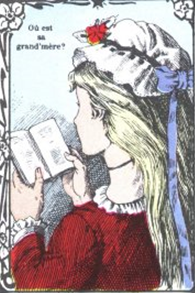My wife and my mother-in-law
My wife and my mother-in- law (English: My Wife and My Mother-In-Law ) is a famous picture puzzle .
The most popular illustration of this motif comes from the English cartoonist William Ely Hill (1887–1962) and appeared in 1915 in the US satirical magazine Puck . The oldest known representation of the young-woman-old-woman tilting figure is on a German postcard from 1888.
description
The special thing about this semantically ambivalent picture is that it can be seen either as a representation of an old or a young woman, since neither the meaning of the individual picture components nor their relationship to one another is fixed. This leads to the fact that the figure-ground relationship / the figure-ground perception changes again and again and that the viewer is offered two alternatives of perception. The viewer sees either a young woman looking backwards or an old woman looking to the left.
- During the change of perception from one point of view to the other, the meaning of the picture elements changes: the ear of the young woman becomes the left eye of the old one; her necklace represents the mouth, her chin the nose of the old woman.
An additional earring makes the young woman easier to perceive. With small circles in place of the black wedge, which then looks like a row of teeth, and omitting the eyelashes and the nose of the young woman, the image of the old woman appears more.
history
Hill's drawing is repeatedly depicted in publications on the psychology of perception, especially gestalt psychology . It was popularized by the psychologist Edwin Boring , who first described it in an article in the American Journal of Psychology and made it known in psychological circles in the 1930s. According to EG Boring, this drawing is also referred to as a Boring figure in English usage . The term boring figure has nothing to do with the English word boring ("boring").
1961 Jack Botwinick recorded based on this drawing a picture with males, he My husband and my father-in (English: My husband and my father-in-law ) called.
Hill did not invent this figure, only interpreted it in 1915. There are much older depictions of the same motif.
meaning
The psychology of perception underscores this drawing their theory that no images of external phenomena arise in the head, and used to this and other photo puzzles, can be read into the two different things. On a website of the University of Ulm it says about the effect of the so-called Boring women :
This picture proves the basic effect of neural attractors without much theoretical ballast. We can see two different motifs in the dot pattern from which the picture is formed: an old woman and a young woman. The recognition of the neural system is “attracted” to these motifs. It is essential that our perception system can switch back and forth between the two possibilities autonomously. Like other pictures, e.g. If, for example, the Necker Cube shows, it is not directly from the will to influence which image is currently being seen.
literature
- Bruno Ernst: The Enchanted Eye, SS 22. Taschen-Verlag, Cologne 1989, ISBN 3-8228-9615-2
- Edwin Boring: A New Ambiguous Figure. American Journal of Psychology 42: 444-445 (1930)
- Jack Botwinick: Husband and Father-in-law: a Reversible Figure. American Journal of Psychology 74: 312-313 (1961)
- Gerald Fisher: Mother, Father, and Daughter: A Three-aspect Ambiguous Figure. American Journal of Psychology 81: 274-277 (1968)
- WE Hill: My Wife and My Mother-in-law. Puck, 11/1915 (November 16)
- E. Wright: The Original of EG Boring's Young Girl / Mother-in-law Drawing and its Relation to the Pattern of a Joke. Perception 21: 273-275 (1992)
Individual evidence
- ^ Entry "young girl / old woman figure" in Andrew Colman: A dictionary of psychology. Oxford University Press, Oxford 2001, ISBN 0-19-866211-4
- ↑ http://mathworld.wolfram.com/YoungGirl-OldWomanIllusion.html
- ↑ http://www.hausarbeiten.de/faecher/hausarbeit/dep/17861.html
- ↑ Boring, Edwin G .: A New Ambiguous Figure, in: The American Journal of Psychology, Vol. 42, No. 3 (Jul.), 1930, pp. 444-445.
- ↑ In German these pictures are also called tilting pictures.


